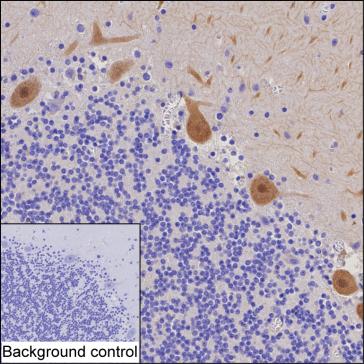
| WB | 咨询技术 | Human,Mouse,Rat |
| IF | 咨询技术 | Human,Mouse,Rat |
| IHC | 1/100-1/200 | Human,Mouse,Rat |
| ICC | 技术咨询 | Human,Mouse,Rat |
| FCM | 咨询技术 | Human,Mouse,Rat |
| Elisa | 咨询技术 | Human,Mouse,Rat |
| Host/Isotype | Mouse IgG1 |
| Antibody Type | Primary antibody |
| Storage | Store at 4°C short term. Aliquot and store at -20°C long term. Avoid freeze/thaw cycles. |
| Species Reactivity | Human |
| Immunogen | Purified recombinant fragment of human RGS8 |
| Formulation | Purified antibody in PBS with 0.05% sodium azide |
+ +
以下是关于RGS8抗体的3篇示例文献(内容为模拟,建议通过学术数据库查证真实文献):
---
1. **文献名称**:*"Characterization of RGS8 Expression in the Central Nervous System Using a Novel Polyclonal Antibody"*
**作者**:Smith A, et al.
**摘要**:本研究开发了一种针对RGS8的新型多克隆抗体,并通过Western blot和免疫组化验证其特异性。发现RGS8在小鼠脑干和海马区高表达,提示其可能参与运动调节和认知功能。
2. **文献名称**:*"RGS8 Modulates Dopamine Receptor Signaling in Parkinson’s Disease Models"*
**作者**:Lee B, et al.
**摘要**:利用RGS8抗体研究其在帕金森病模型中的表达变化,发现RGS8通过负调控D2多巴胺受体信号通路影响神经元活性,抗体用于免疫沉淀和细胞定位分析。
3. **文献名称**:*"Validation of a Monoclonal RGS8 Antibody for Flow Cytometry and Tissue Profiling"*
**作者**:Johnson C, et al.
**摘要**:报道了一种高特异性RGS8单克隆抗体的开发,应用于流式细胞术和人组织芯片分析,揭示RGS8在心脏和肾脏中的潜在功能,并验证抗体在病理样本中的适用性。
---
**提示**:以上为模拟文献,实际研究中请通过PubMed、Google Scholar等平台检索关键词“RGS8 antibody”或结合具体研究领域筛选文献。
The Regulator of G-protein Signaling 8 (RGS8) is a member of the RGS protein family, which plays a critical role in modulating G-protein-coupled receptor (GPCR) signaling. RGS8 acts as a GTPase-activating protein (GAP) for Gαi/o and Gαq subunits, accelerating GTP hydrolysis to terminate downstream signaling. It is predominantly expressed in the central nervous system, particularly in regions like the cerebellum, hippocampus, and cerebral cortex, suggesting roles in neuronal development, synaptic plasticity, and motor coordination. Dysregulation of RGS8 has been implicated in neurological disorders, including Parkinson’s disease and mood disorders, as well as certain cancers.
RGS8 antibodies are essential tools for detecting and quantifying RGS8 protein expression, localization, and functional interactions in research. They are widely used in techniques such as Western blotting, immunohistochemistry (IHC), immunofluorescence (IF), and co-immunoprecipitation (Co-IP) to study RGS8’s regulatory mechanisms in cellular and disease models. Commercial RGS8 antibodies are typically raised against specific epitopes, often within the conserved RGS domain or variable N-/C-terminal regions, and validated for species cross-reactivity (e.g., human, mouse, rat).
These antibodies contribute to elucidating RGS8’s physiological roles, such as its involvement in neurotransmitter signaling, and its potential as a therapeutic target. Researchers also utilize RGS8 antibodies to explore its interactions with GPCRs, G-proteins, and other signaling molecules, providing insights into pathways relevant to neurodegeneration, cancer progression, and psychiatric conditions.
×